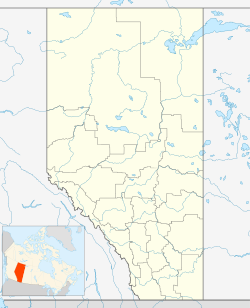Drumheller
| Drumheller | ||
|---|---|---|
| Town | ||
| Town of Drumheller | ||

The view out of "World's Largest Dinosaur" across Drumheller
|
||
|
||
| Nickname(s): Dinosaur Capital of the World | ||
| Location of Drumheller in Alberta | ||
| Coordinates: 51°27′49″N 112°43′10″W / 51.46361°N 112.71944°W | ||
| Country |
|
|
| Province |
|
|
| Region | Southern Alberta | |
| Census division | 5 | |
| Founded | 1912 | |
| Incorporated | ||
| • Village | May 15, 1913 | |
| • Town | March 2, 1916 | |
| • City | April 3, 1930 | |
| • Town | January 1, 1998 | |
| Amalgamated | January 1, 1998 | |
| Government | ||
| • Mayor | Terry Yemen | |
| • Governing body |
Drumheller Town Council
|
|
| • CAO | Ray Romanetz | |
| • MP | Kevin Sorenson (Crowfoot) | |
| • MLA | Rick Strankman (Drumheller-Stettler) | |
| Area (2016) | ||
| • Land | 108.03 km2 (41.71 sq mi) | |
| Elevation | 670 m (2,200 ft) | |
| Population (2016) | ||
| • Total | 7,982 | |
| • Density | 73.9/km2 (191/sq mi) | |
| Time zone | MST (UTC−7) | |
| • Summer (DST) | MDT (UTC−6) | |
| Postal code span | T0J | |
| Area code(s) | +1-403, +1-587 | |
| Website | Official website | |
Drumheller /drʌmˈhɛlər/ is a town (formerly a city) within the Red Deer River valley in the badlands of east-central Alberta, Canada. It is located 110 kilometres (68 mi) northeast of Calgary. The Drumheller portion of the Red Deer River valley, often referred to as Dinosaur Valley, has an approximate width of 2 kilometres (1.2 mi) and an approximate length of 28 kilometres (17 mi).
The town is named for Colonel Samuel Drumheller, who bought land in 1910 and started coal mining operations there in 1911. Drumheller became a railway station in 1912. It then incorporated as a village on May 15, 1913, a town on March 2, 1916 and a city on April 3, 1930. Over a 15-year period, Drumheller's population increased 857% from 312 in 1916 to 2,987 in 1931 shortly after becoming a city.
The City of Drumheller amalgamated with the Municipal District (MD) of Badlands No. 7 on January 1, 1998 to form the current Town of Drumheller. Some of the reasons the two municipalities amalgamated included the MD of Badlands No. 7 having more in common with Drumheller than other surrounding rural municipalities and both were experiencing similar planning and development issues due to their locations within the Red Deer River valley. The amalgamated municipality opted for town status rather than city status so that highways within would remain the responsibility of the Province of Alberta. As a result of the amalgamation, Drumheller became Alberta’s largest town in terms of land area at 107.93 square kilometres (41.67 sq mi).
The 1998 amalgamation resulted in Drumheller absorbing six hamlets that were previously under the jurisdiction of the MD of Badlands No. 7 – Cambria, East Coulee, Lehigh, Nacmine, Rosedale and Wayne. Drumheller also previously absorbed the hamlets of Bankview, Midlandvale (Midland), Newcastle and North Drumheller during annexations while under city status. Bankview and Midland were annexed in 1964 and 1972 respectively, while Newcastle and North Drumheller were both annexed in 1967. Other localities within Drumheller, either absorbed through past annexations or its eventual amalgamation with the MD of Badlands No. 7, include Aerial, Eladesor, Kneehill, Rosedale Station, Western Monarch (Atlas) and Willow Creek.
...
Wikipedia


